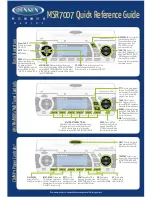
Honeywell Process Solutions
Wireless Dual Analog Input Interface Transmitter
Rev. 8
User Manual
7
July 2012
3.2: Testing Communications
Remember, proper placement of the Transmitter will optimize your RF
communication range and capabilities. Perhaps the best test to perform
before mechanically mounting the unit is a quick hand-held test. There are
two types of tests you can conduct: the RSSI (Received Signal Strength
Indicator) Diagnostic and the Link Test. The RSSI Diagnostic measures
the strength of the signal at the Transmitter. The Link Test measures the
throughput of data sent to and from the Transmitter. The Link Test may be
conducted from the Transmitter, Base Radio, or through WMT.
The RSSI Diagnostic should be conducted first to determine if the Base
Radio is communicating with the Transmitter. Then the Link Test may be
performed to test the validity of the installation.
To perform these tests you should have a good idea of where the Base
Radio will be placed (for more information see Section 3 of the Base Ra-
dio User Manual). Place the Base Radio in the desired area and power on.
Make sure that the Base Radio and Transmitter are on the same RF Chan-
nel and Baud Rate (See Section 5). You may also have to increment the
number of Transmitters with which the Base Radio is communicating (See
the Base Radio User Manual Section 4.3).
Once both the Base Radio and Transmitter are set up to be on the same
network, make sure communication is established by looking at the Trans-
mitter LCD for the ‘RF OK’ message in the Read-Only Sequence (see
Section 4.1.1).
After communications have been established, go to Section 3.2.1 for the
RSSI Diagnostic or Section 3.2.2 for the Link Test.
3.2.1: Transmitter RSSI Diagnostic
The Transmitter should be placed in RSSI Diagnostic mode to determine
the signal strength at the location of the equipment to be monitored.
The RSSI Diagnostic, located in the Transmitter’s diagnostic menu,
displays the RF signal strength in one of seven ranges. The signal strength
is displayed on the LCD using a combination of ‘>’ and ‘_’ characters.
Full signal strength is displayed as “> > > > > > >” while minimum signal
strength is displayed as “> _ _ _ _ _ _”. If the Transmitter is not
communicating with the Base Radio (i.e. NO RF), all underscore
characters will be displayed (“_ _ _ _ _ _ _”).
The RSSI is measured every time the Transmitter receives a message from
the Base Radio. The signal strength of the received message from the Base
Radio is calculated during this time. The actual signal strength in dBm for
each range is shown below:
> > > > > > >
Less
than Between Between Between Between Between
Greater
than
-105 dBm
-105 dBm & -100 dBm & -95 dBm & -90 dBm & -85 dBm &
-80 dBm
-100 dBm
-95 dBm
-90 dBm
-85 dBm
-80 dBm
NOTE
The RSSI Diagnostic may only be conducted from
Transmitters versions 1.56 and higher. The
version number may only be checked when the
Transmitter is powered up. See Figure 4.1.
Summary of Contents for XYR 5000 Series
Page 2: ......














































